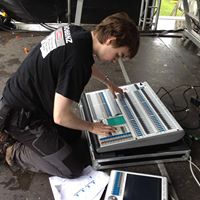Adam E Robbins
age ~35
from Superior, AZ
- Also known as:
-
- Adam Edward Robbins
- Adamedward Robbins
Adam Robbins Phones & Addresses
- Superior, AZ
- Los Molinos, CA
- Escondido, CA
- Chico, CA
- Magalia, CA
- Gerber, CA
- Chula Vista, CA
Work
-
Company:Tomar water systems
-
Address:804 N Twin Oaks Valley Rd, San Marcos, CA 92069
-
Phones:7605109770
-
Position:Owner
-
Industries:Business Services
Us Patents
-
Patient Temperature And Heartbeat Rate Monitoring System
view source -
US Patent:46869980, Aug 18, 1987
-
Filed:Nov 12, 1985
-
Appl. No.:6/797164
-
Inventors:Adam Robbins - San Marcos CA
-
Assignee:Mediscan Research Limited - Pasadena CA
-
International Classification:A61B 502
-
US Classification:128670
-
Abstract:Hospital patient temperatures and heartbeat rates are monitored by providing each patient with a battery powered transmitter containing a reference resistance and to which two sensor electrodes are connected. The first electrode includes a thermistor and is positioned in thermal contact with the patient's skin over the axillary artery. The second electrode is positioned in contact with the patient's skin proximate to the fourth intercostal left parasternal area of the patient's chest. A receiver, carried by a nurse, includes a magnetic actuator for closing a reed switch in a transmitter unit to activate the generation of data signals from that transmitter. The transmitter, when actuated provides an output of modulated, sequential data signals. The data signals are of a duration corresponding to a reference temperature, actual patient temperature, transmitter battery level, and patient heartbeat rate. The receiver includes demodulator circuitry and a microprocessor to provide numerical indicia quantitatively indicative of actual patient temperature and heartbeat rate.
-
Reverse Osmosis Purification System
view source -
US Patent:61905585, Feb 20, 2001
-
Filed:Apr 1, 1999
-
Appl. No.:9/283682
-
Inventors:Adam Robbins - San Marcos CA
-
Assignee:Nimbus Water Systems, Inc. - San Marcos CA
-
International Classification:B01D 6100
-
US Classification:210652
-
Abstract:A reverse osmosis water purification system for providing potable water from a municipal water or other source containing undesired impurities. A motor driven pump supplies a feed stream to a reverse osmosis unit resulting in the creation of a product water stream and a concentrate or brine stream. The inclusion of a product water holding tank may be optionally omitted by routing the product water outlet stream directly to the tap via a branched line. A pressure sensor causes a solenoid valve to open when the withdrawal of water from the tap is terminated, opening a valve in the branch line leading back to the pump. The pump then continues to run, recirculating the product water stream to a mixing unit where it is blended with a major part of the concentrate stream that is being recycled and with make-up fresh water to create a composite feed stream. As the system continues to run in this recirculation mode, the composite feed stream entering the purification unit becomes gradually purer, and once the quality reaches a desired level, the system is placed in shutdown mode. Because of the high quality of the water on the feed side of the membrane in the reverse osmosis unit, little contamination of the purified water on the product side occurs during shutdown.
-
Semipermeable Membrane Cartridge And Method Of Making
view source -
US Patent:51086042, Apr 28, 1992
-
Filed:Aug 23, 1991
-
Appl. No.:7/749151
-
Inventors:Adam Robbins - San Marcos CA
-
Assignee:Desalination Systems, Inc. - Escondido CA
-
International Classification:B01D 6310
-
US Classification:21032174
-
Abstract:Cartridges for use in ultrafiltration or reverse osmosis separation devices are formed by injection molding a generally tubular, smooth, seamless shell about a spirally-wrapped semipermeable membrane assembly. These cartridges can be used within traditional separation devices having pressure vessels of precise interior diameter, for which the cartridges are uniquely suited because they have cylindrical surfaces of true circular cross-section and close tolerances. The cartridges can also be created so as to incorporate integral pressure vessels and thus permit their use in separation processes without the need for surrounding supporting pressure vessels. A reaction injection molding process is shown which provides for substantial efficiencies in the overall manufacturing of semipermeable membrane separation cartridges of the spirally-wound variety.
-
Water Purification Unit
view source -
US Patent:D3778266, Feb 4, 1997
-
Filed:Feb 23, 1996
-
Appl. No.:D/050790
-
Inventors:Adam Robbins - San Marcos CA
-
Assignee:Nimbus Water Systems, Inc. - San Marcos CA
-
US Classification:D23209
-
Water Purification Unit
view source -
US Patent:D3776778, Jan 28, 1997
-
Filed:Feb 23, 1996
-
Appl. No.:D/051031
-
Inventors:Adam Robbins - San Marcos CA
-
Assignee:Nimbus Water Systems, Inc. - San Marcos CA
-
US Classification:D23209
Resumes

Senior Loan Advisor
view sourceWork:
Lower
Senior Loan Advisor
Senior Loan Advisor

Adam Robbins
view source
Adam Robbins
view source
Adam Robbins
view sourceIndustry:
Electrical/Electronic Manufacturing
Work:
Pci
Vice President Business Development
Vice President Business Development
Name / Title
Company / Classification
Phones & Addresses
Owner
Tomar Water Systems
Business Services
Business Services
804 N Twin Oaks Valley Rd, San Marcos, CA 92069
Website: tomarwater.com
Website: tomarwater.com
Chief Executive
Realty World-Imperial
Real Estate Agents and Managers
Real Estate Agents and Managers
2423 Hoover Avenue, National City, CA 91950
President, Owner
TOMAR WATER SYSTEMS INC
Water Purification Systems Mfg · All Other Business Support Svcs
Water Purification Systems Mfg · All Other Business Support Svcs
804 N Twin Oaks Vly Rd, San Marcos, CA 92069
7605109770
7605109770
Chief Executive
Realty World-Imperial
2423 Hoover Ave, National City, CA 91950
8189992097
8189992097
WHITEWATER WISDOM LLC
PO Box 8821, Chico, CA 95927
1344 Cv Hl Rd, Weirton, WV 26062
101 Heslep Ave, Fayetteville, WV 25840
1344 Cv Hl Rd, Weirton, WV 26062
101 Heslep Ave, Fayetteville, WV 25840
License Records
Adam M Robbins
License #:
E038291 - Active
Category:
Emergency medical services
Issued Date:
Jan 9, 2010
Expiration Date:
May 31, 2018
Type:
San Diego County EMS Agency

Adam D Robbins
view source
Adam Robbins III
view source
Adam Christopher Robbins
view source
Adam Robbins
view source
Adam Robbins
view source
Adam Robbins Whosoever
view source
Adam Robbins
view source
Adam Robbins
view sourceMyspace
Googleplus

Adam Robbins
Work:
Perseid LED - Owner
MMS-SMS LLC - Owner (2012)
MMS-SMS LLC - Owner (2012)

Adam Robbins
Tagline:
Jumping the void in a muscle car made a' gold

Adam Robbins

Adam Robbins

Adam Robbins

Adam Robbins

Adam Robbins

Adam Robbins
Flickr
Youtube
Classmates

Adam Robbins (Rossi)
view sourceSchools:
Arlington Junior High School Poughkeepsie NY 1978-1982
Community:
Timothy Odell, Christine Corey

Adam Robbins
view sourceSchools:
North River Elementary School Truro Swaziland 1995-1999
Community:
Nicole Hollingsworth, Evan Whidden, Martha Curry, Darlene Cook

Adam Robbins Jr.
view sourceSchools:
George Washington Carver High School Sweeny TX 1960-1964
Community:
Florence Bowers, Dorothy Bernard

Adam Robbins
view sourceSchools:
St. Julie Billiart School Hamilton OH 1987-1995
Community:
Bruce Combs, Christine Maupin

Adam Robbins
view sourceSchools:
St. Theresa Shrine Elementary School Scarborough Morocco 1992-2001
Community:
Mark Chapel, Nick Stathakis, Charlene Macpherson, Frank Allen

Adam Robbins
view sourceSchools:
Fairfield High School Fairfield TX 1989-1993
Community:
Kathy Martin, Teresa Holder, Joyce Reeves, Ricky Missildine

Adam Robbins
view sourceSchools:
Laney High School Wilmington NC 1994-1998
Community:
Sebrina Rawley

Adam Robbins | B. R. Mill...
view sourceNews

'Star Wars'-themed kids activities inspire 'Rogue One' interest
view source- Adam Robbins was at the Jedi event Sunday afternoon with his 5-year-old son, Caleb, who wore paper Yoda ears on his head. He made the ears earlier in the day, along with a Chewbacca bookmark and a BB-8 droid created from a paper plate.
- Date: Dec 11, 2016
- Category: Entertainment
- Source: Google
Get Report for Adam E Robbins from Superior, AZ, age ~35

















